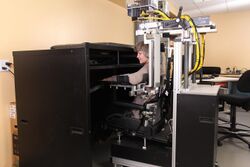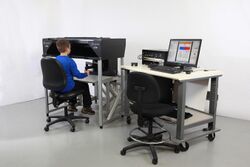Engineering:KINARM
Kinesiological Instrument for Normal and Altered Reaching Movement (KINARM)[1] is an interactive robotic device designed to assess the sensorimotor and cognitive function of the brain through behavioural tasks using the upper limb. There are two types of KINARMs - the KINARM Exoskeleton and the KINARM End-Point. The technology is used by both basic and clinical researchers in order to develop a greater understanding of the neurological impacts of a variety of injuries and diseases. KINARMs allow researchers to collect more objective and quantitative data for assessing brain function than traditional methods.[2] The devices are created by BKIN Technologies Ltd., doing business as Kinarm, in Kingston, Ontario.
History
The first KINARM robot to be created was the KINARM Exoskeleton. It was developed in 1999 by Stephen Scott, a neuroscientist and researcher at Queen's University.[3] The KINARM Exoskeleton was commercialized in 2004[4] when BKIN Technologies was founded by Dr. Scott and Dr. Ian Brown with the assistance of PARTEQ Innovations.[5]
Product
KINARM robots assess the user's ability to interact with a two-dimensional virtual reality environment using their upper limbs. The KINARM Exoskeleton uses a motorized exoskeleton to measure and manipulate the function of the upper limbs and is produced in both human and non-human primate (NHP) versions. The KINARM End-Point uses hand-held robotic rods and is used primarily for human use. Both robot labs are available with gaze-tracking technology.[6]
As of 2018, there were roughly 100 KINARM labs distributed in 14 countries worldwide.[7]
KINARM standard tests
The KINARM Standard Tests (KST) form a library of automated behavioural tasks designed for use with KINARMs. The KST database has been extensively used in research publications and has created a universal platform for the comparison of data on neurological function among normal and impaired human populations.[8][9][10]
Applications
There are over 275 published peer-reviewed journal articles that use KINARM Labs.[11]
KINARM Labs are being used for concussion evaluation in high-performance athletes at the Canadian Winter Sport Institute as a part of the Canadian Olympic Committee's national concussion strategy.[12][13]
See also
References
- ↑ "Prof invents first ever objective brain function assessment tool". https://www.queensjournal.ca/story/2010-12-02/prof-invents-first-ever-objective-brain-function-a/.
- ↑ Rhamey, Ashley (Aug 13, 2017). "Robots and research". Kingston Whig-Standard (Kingston). https://www.thewhig.com/2017/08/13/robots-and-research/wcm/cf90f457-0bbd-b1d9-fb1d-3eb068fe3734.
- ↑ Scott, S.H. (July 1999). "Apparatus for measuring and perturbing shoulder and elbow joint positions and torques during reaching". Journal of Neuroscience Methods 89 (2): 119–127. doi:10.1016/S0165-0270(99)00053-9. PMID 10491942.
- ↑ "BKIN Technologies Ltd.". https://trilliummfg.ca/profile/kinarm/.
- ↑ Mathison, Dick (Nov 23, 2010). "New technology enables better assessment of brain injuries". Kingston Herald. Kingston. http://kingstonherald.com/tech/technology-enables-brain-injuries-assessment-201032866.
- ↑ "KINARM". May 10, 2018. https://www.physio-pedia.com/KINARM.
- ↑ Willson, Andrew (Dec 4, 2018). "Stephen Scott's robot is changing what we know about the brain". Dean's Blog (Queen's University Faculty of Health Sciences). https://healthsci.queensu.ca/stephen-scotts-robot-changing-what-we-know-about-brain.
- ↑ Centen, A.; Lowrey, C.R.; Scott, S.H.; Yeh, T.T.; Mochizuki, G. (June 2017). "KAPS(Kinematic Assessment of Passive Stretch): a tool to assess elbow flexor and extensor hypertonicity after stroke using a robotic exoskeleton". Journal of NeuroEngineering and Rehabilitation 14 (1): 59. doi:10.1186/s12984-017-0272-8. PMID 28629415.
- ↑ Bourke, T.C.; Lowrey, C.R.; Dukelow, S.P.; Bagg, S.D.; Norman, K.E.; Scott, S.H. (October 2016). "A robotic task quantifies post-stroke impairments in rapid motor decisions and actions". Journal of NeuroEngineering and Rehabilitation 13 (91): 91. doi:10.1186/s12984-016-0201-2. PMID 27724945.
- ↑ Tyryshkin, K.; Coderre, A.; Glasgow, J.I.; Herter, T.M.; Bagg, S.D.; Dukelow, S.P.; Scott, S.H. (April 2014). "A robotic object hitting task to quantify sensorimotor impairments in participants with stroke". Journal of NeuroEngineering and Rehabilitation 11 (1): 47. doi:10.1186/1743-0003-11-47. PMID 24693877.
- ↑ "Publications by Research Area". https://www.bkintechnologies.com/clinical-applications/publications-by-research-area/?view=all.
- ↑ Fletcher, Robson (Mar 18, 2019). "Canada adopts new national concussion strategy for high-performance athletes". CBC News (Calgary). https://www.cbc.ca/news/canada/calgary/national-concussion-strategy-olympic-announcement-calgary-1.5060956.
- ↑ MacQueen, Ken (Jul 17, 2012). "Team Canada's gold medal secrets". MacLean's magazine (Rogers Media). https://www.macleans.ca/society/gold-medal-secrets/.
External links
 |



